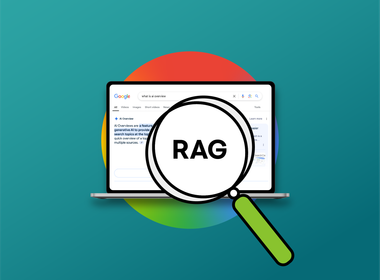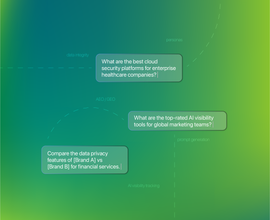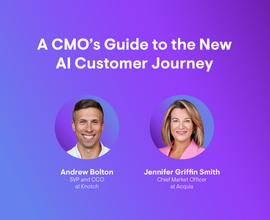What Is Retrieval-Augmented Generation (RAG)?
One key drawback of AI-generated content and AI search is that LLMs and AI models can often provide incorrect information, generate irrelevant content, and even hallucinate things that never occurred. This increases the chance of creating subpar content that’s full of inaccuracies and misinformation, putting your brand’s authority, expertise, and visibility at risk. The good news is that there's a technique working to ensure that AI models can access the most relevant and up-to-date information possible. It’s called Retrieval-Augmented Generation (RAG), and it's the key to making AI not just creative, but also credible.
What is retrieval-augmented generation (RAG)?
Retrieval-augmented generation, or RAG, is an AI optimization technique with the goal of making large language models (LLMs) more efficient, more accurate, and more reliable. RAG allows an AI model to leverage relevant, up-to-date information before it answers a question, instead of relying solely on its static, pre-trained memory, which can often have a knowledge cutoff.
With RAG, the AI can pull current, factual data from external sources, from specific websites to a company's internal knowledge base, or the internet in real-time. It then uses this freshly retrieved information to power or enhance its output.
RAG is a technique that allows LLMs to generate more personalized and meaningful content. Basically, instead of just using the information that ChatGPT has been trained on, it allows you to give ChatGPT additional context for every single thing that you're asking to be generated, like word count, search signal content, or other best-performing content.
For marketers, RAG is the key to leveraging AI to create high-quality, on-brand content much faster, without having to constantly train the model on your specific industry nuances and brand guidelines or edit and revise generated copy.
By grounding the AI's response in a specific, controlled set of information, it also reduces the risk of the AI hallucinating or making up incorrect information. In short, RAG ensures that your content is not only fresh and unique but also relevant to your target topic and satisfies audience search intent.
How RAG ensures stronger AI-generated content
RAG connects the power of an LLM to a live set of curated information to enhance its already massive index of data and information. This enhanced data foundation elevates the quality and trustworthiness of AI output in several key ways. First, it ensures factual accuracy. When an AI can pull from a real-time data source, it can confidently cite statistics, reference recent events, and speak accurately about product details, overcoming the "knowledge cutoff" problem inherent in standard models.RAG also helps to maintain your brand’s authority, expertise, voice, and tone. You can direct the AI to retrieve information exclusively from your own approved content on your website, to help articles, and brand guidelines. This gives you a powerful level of control, turning a general-purpose AI into a knowledgeable, on-brand content expert.
The RAG approach gives you content that's not just well-written, but actually useful, current, and specific to your business context. It's like having an AI that can think and do research in real time.
Leveraging RAG: The Conductor difference
At Conductor, RAG is a core component of our AI engine, Conductor AI. It’s how we ensure that the recommendations and insights you receive are not just intelligent, but are also grounded in the most relevant and timely data possible.
While other solutions rely on pre-trained knowledge, Conductor's RAG-based approach continuously pulls from your full website data, real-time authoritative sources, and our database of traditional and AI success factors. This ensures teams can generate winning content at speed and scale, earning audience trust and share of voice across search and LLMs.When you ask Writing Assistant to analyze a problem or suggest a strategy, our RAG process is working in the background, retrieving the freshest, most relevant information from all your connected data sources. This process allows our AI to provide smarter, more reliable recommendations that guide you on exactly where to act and how to execute.
Our approach to RAG is about really prioritizing the data quality. When you are engaging with an AI answer engine, it’s important to have the option to have your response, what we call, ‘grounded in search.’
The benefit of that is, like, it's pulling from real-time, up-to-date, accurate information. A lot of times, if these AI models are working purely off of their own indexes or training data, you're just not going to get the right information sometimes.
For marketers, RAG represents a crucial step forward in using AI with confidence. By ensuring that AI-generated content is accurate, brand-safe, and contextually aware, RAG transforms a powerful tool into a reliable strategic partner. As you evaluate AI solutions, understanding whether they leverage RAG is key to ensuring you're harnessing the full, trustworthy power of artificial intelligence.

![Wei Zheng, Chief Product Officer, [object Object]](https://cdn.sanity.io/images/tkl0o0xu/production/dcfa62c0fe34ba0c31f910b818874cd160ad8839-3542x3542.png?fit=min&w=100&h=100&dpr=1&q=95)
![Alexandra Dritsas, Principal Solutions Consultant, [object Object]](https://cdn.sanity.io/images/tkl0o0xu/production/56e05fe9c1e6c71cd4fa8ed0e6368e43c9679480-1765x1765.png?fit=min&w=100&h=100&dpr=1&q=95)
![Jenny Li, Director of Product Marketing, [object Object]](https://cdn.sanity.io/images/tkl0o0xu/production/0cf2880c77e134c2c52395bb7906a3ac8d2e4dc4-300x300.jpg?fit=min&w=100&h=100&dpr=1&q=95)






